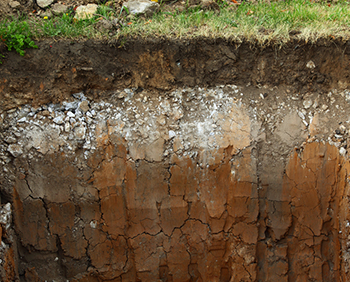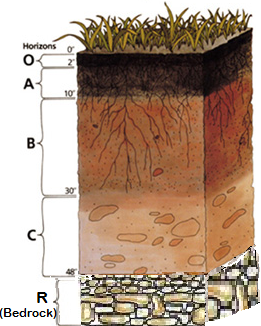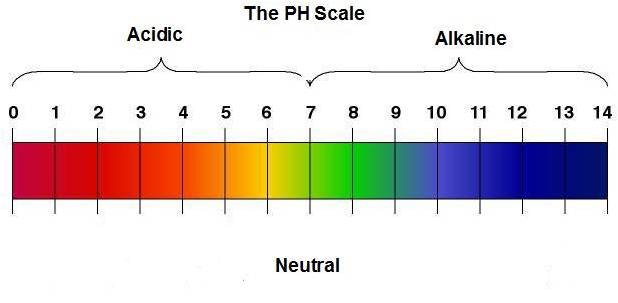Learn

Soil
Soil is composed of inorganic material from minerals and rocks (parent material), organic material from living organisms (or once living organisms and waste products from living organisms), air, and water.
The average soil sample consists of 45% inorganic material, 25% water, 25% air, and 5% organic matter. The inorganic material in soil provides physical support for plants. The organic material, water, and air provide the essential nutrients for plants to grow.

Soil is more than it seems.

Soil Horizons
 Soil usually has four distinct layers. The different soil layers are referred to as soil horizons. A section of soil that reveals all the different soil horizons is called a soil profile. Soil profiles are important in determining the nutrient level of the soil. They are used in agriculture to help determine the types of plants that will grow in certain soils. Engineers and architects in the construction industry also rely on soil profiles to help them determine what structures can be built in certain areas and what engineering and construction techniques may need to be used in certain areas.
Soil usually has four distinct layers. The different soil layers are referred to as soil horizons. A section of soil that reveals all the different soil horizons is called a soil profile. Soil profiles are important in determining the nutrient level of the soil. They are used in agriculture to help determine the types of plants that will grow in certain soils. Engineers and architects in the construction industry also rely on soil profiles to help them determine what structures can be built in certain areas and what engineering and construction techniques may need to be used in certain areas.
The very top layer of soil is referred to as the O Horizon. It is a very thin, dark layer that is made up of living organisms, such as bugs, plants, and decomposing material, such as leaves. There are varying degrees of decomposed organic material–from highly decomposed to minimally decomposed material.
The layer directly below the O Horizon is called A Horizon. This layer of soil is often referred to as topsoil. Topsoil is considered the most productive soil layer. This layer is made up of minerals and decomposed organic material. Like the O Horizon, it also has a very dark color. Most plant roots grow in this layer of soil.
The B Horizon is directly below A Horizon and is often referred to as the subsoil. This soil is lighter in color and has less organic material than the layers above it. It is composed mostly of clay and mineral deposits.
The C Horizon is the layer directly below B Horizon and above the bedrock. C Horizon has very little organic material and is mostly composed of slightly broke rock (parent material). Plant roots are not found in this layer of soil.
Bedrock is the solid rock located beneath the layers of soil. It is made up of either igneous rock, sedimentary rock, or metamorphic rock. It serves as the parent material for the soil. Broken down bedrock contributes to the inorganic material in the soil.
The number of layers in soil is not always the same. The number varies by geographic region; some areas still have exposed bedrock where soil formation has not yet begun.

Classifications
Soils can be classified based on several physical and chemical characteristics:
- texture
- porosity
- color
- pH
Soil texture is a physical characteristic that describes the look and feel of the soil. There are three basic types of soil texture:
- sand,
- silt, and
- clay.
Soil porosity is the amount of space between particles. Smaller particles have smaller pore size, so water tends not to flow through this very easily. Clay is an example of this type of soil and holds water. Larger particles have larger pore size, so water tends to flow more freely through sand. The catch to this is that, even though clay has the smaller pore size, there is more overall space in all the pores. So, we can say that the particle size is inversely related to porosity. The smaller the particle size of the soil, the greater the porosity. Soils are typically a mixture of sand, silt, and clay rather than being 100% of one type, so a soil's texture, porosity, and ability to hold water will vary based on the overall composition/makeup of the soil.
Soil color is influenced by the amount of organic matter, the minerals present, and moisture present. Usually the more organic matter present, the darker the soil. Wetter soils are typically darker than dryer soils. Soil color can tell us if the soil is high in organic matter high organic matter indicates rich soil good for growing , how well it drains, if the soil is wet or dry.
Soil pH is a chemical characteristic of soil. Soil pH deals with the acidity or alkalinity of the soil. This is measured by the concentration of hydrogen ions (H+) in the soil. As the concentration of hydrogen ions increase, the pH of the soil decreases, meaning the soil becomes more acidic. Soils with a pH under 5 are considered acidic. Soils with a pH over 7.5 are considered alkaline. The pH of the soil determines what type of plants can grow and organisms can exist and thrive in the soil.

The soil pH in an area is influenced by the
- type of parent material - some rock material is acidic and some is more alkaline,
- amount of precipitation - as the amount of precipitation increases, the acidity of the soil decreases,
- type of native plant life - coniferous trees needles are more acidic than broad leaf trees,
- type of crops grown - legumes make soil more acidic than corn or sorghum,
- use of nitrogen based and organic fertilizers - these increase the acidity of soil,
- burning of fossil fuels - adding sulfur dioxide to air contributes to acid rain which can increase soil acidity, and
- using underground irrigation water - makes the soil less acidic.
 |
 |